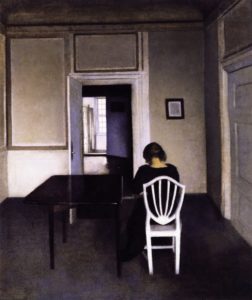There are many ways to describe the transitions in our lives. We may use metaphors and refer to opening doors or windows, crossing thresholds, climbing ladders or stairs, passing milestones, choosing paths or roads, undergoing metamorphosis, and even giving birth. Metaphors allow us to use simple words and phrases to describe complex changes, thereby grounding them in concrete, common actions, normalizing them.

Vilhelm Hammershøi, Interior: Strandgade 30 (1901), by Gandalf’s Gallery is licensed under CC BY-NC-SA 2.0
Metaphors are used not only in ordinary conversation but also in scholarly discourse. Social scientists draw on metaphorical language when they refer to “liminal spaces” during life transitions; these spaces are the “in-between” stages, when a person has left one form of life behind but has not yet fully assumed a new form of life. In a liminal space, you are both going and coming; you haven’t yet arrived. The word “liminal” comes from the Latin limen, meaning “threshold.” To be in a liminal space means to be in the doorway itself, that is, in the midst of the life transition or change.
I’ve been thinking a lot about liminal spaces lately. In June, I entered a new stage of my Poor Clare formation. I became a novice, began wearing the habit and being addressed as “Sister,” and bound myself more closely to this community. I crossed a threshold; I moved through a door.

Vilhelm Hammershøi, Interior with Ida in a White Chair (c. 1900), by irinaraquel is licensed under CC PDM 1.0
Thresholds and doors remind me of the paintings of Hammershøi, which often show the back of a woman sitting before a door that is slightly ajar. When you look at these paintings, you have a view slightly wider than that of the woman; you gaze in the same direction. Hammershøi’s paintings can therefore be useful tools for contemplation. What does this woman see? What is her situation? How long has she been sitting there? What do you see and feel as you look at this painting?
There is an element of mystery to Hammershøi’s paintings. Some folks find the various stages of religious life mysterious as well, especially since different orders and communities sometimes use different terms for these stages. “When do you take your vows?” “What exactly is a novice?” From outside the cloister, a new Poor Clare may look as mysterious as the woman in Hammershøi’s paintings. What is she doing and why?
If you have ever wondered about the steps in becoming a Poor Clare, read on. And know that “becoming” is the operative word! We are always “becoming,” allowing ourselves to be formed by God and by each other so that we can truly be mirrors of the Poor Christ, as St. Clare urged.
Here, then, is a brief outline of the steps, doors, and milestones in the life of a Poor Clare.
- Inquirer
This stage begins when a woman contacts the sister who serves as vocation director. The vocation director is the inquirer’s main contact with the community, and she is available to answer questions, provide information, and accompany the inquirer in her discernment. During this time, the inquirer has the opportunity to visit the monastery and learn more about the Poor Clare life.
Duration: A year or more
Note: To proceed to each of the following stages, the individual goes through a formal review process and then submits an application or petition to the abbess. The abbess shares the individual’s request with the chapter (i.e. the sisters who’ve made their solemn vows), and chapter members then vote on whether or not to grant the request.
- Candidate
A candidates lives within the cloister with the sisters and participates in their daily life, keeping their schedule, sharing in their work, and entering more fully into their life of prayer. A candidate also usually has the opportunity to sit in on classes taught by the sisters. This extended live-in experience, which used to be called the “long visit,” allows the candidate to get to know the sisters and the Poor Clare life more deeply; it also provides the sisters with the opportunity to get to know the candidate better and to discern her vocation with her.
Duration: 3-6 months - Postulant
After a candidate completes her live-in experience and returns home, she continues to discern her vocation and talk with the vocation director. She may decide to apply to enter the monastery as a postulant. If she is accepted, she begins to put her affairs in order. Because she can only bring a few personal items with her, she will need to give up her cell phone, car, computer, etc. and find homes for her other belongings.
When her postulancy begins, she will participate fully in the daily life of a Poor Clare. She will take classes in Scripture, theology, and Franciscan studies (all taught by sisters in the community), and she will be given specific work charges. Over the course of the year, she will gradually take on more responsibility, always with the direction and support of the formation director. Throughout her postulancy, she will continue to discern her vocation.
Duration: approximately 1 year - Novice
The day that a sister becomes a novice is known as her reception day, and on this day, she becomes a formal member of the community and begins wearing the habit and being formally addressed as “Sister.” The novitiate is a period of deeper discernment, study, and reflection as the sister learns more about the Rule, Constitutions, and vows of the Poor Clares.
Duration: 2 years - First Profession (Simple Vows)
A sister’s first vows are temporary vows. In other words, she is still free to leave the monastery if she and the community discern that her vocation lies elsewhere. After a sister makes her first profession, she assumes more responsibility in the community and enters fully into the life of a Poor Clare while she and the community continue to discern if she is called to the spend the rest of her life as a cloistered, contemplative nun.
Duration: 3-6 years - Solemn Profession (Solemn Vows)
At solemn profession, a Poor Clare makes her permanent vows, promising to live “in obedience, without anything of my own and in chastity” and “to observe enclosure.” She will be bound by these vows for the rest of her life. A Poor Clare’s formation never ends, however. Each day, she seeks conversion, which is nothing less than the continual turning of her face and her heart to God.
Duration: until death
Death is not simply the end of a Poor Clare’s earthly life but also the final threshold of formation, as the sister is born into eternal life.

